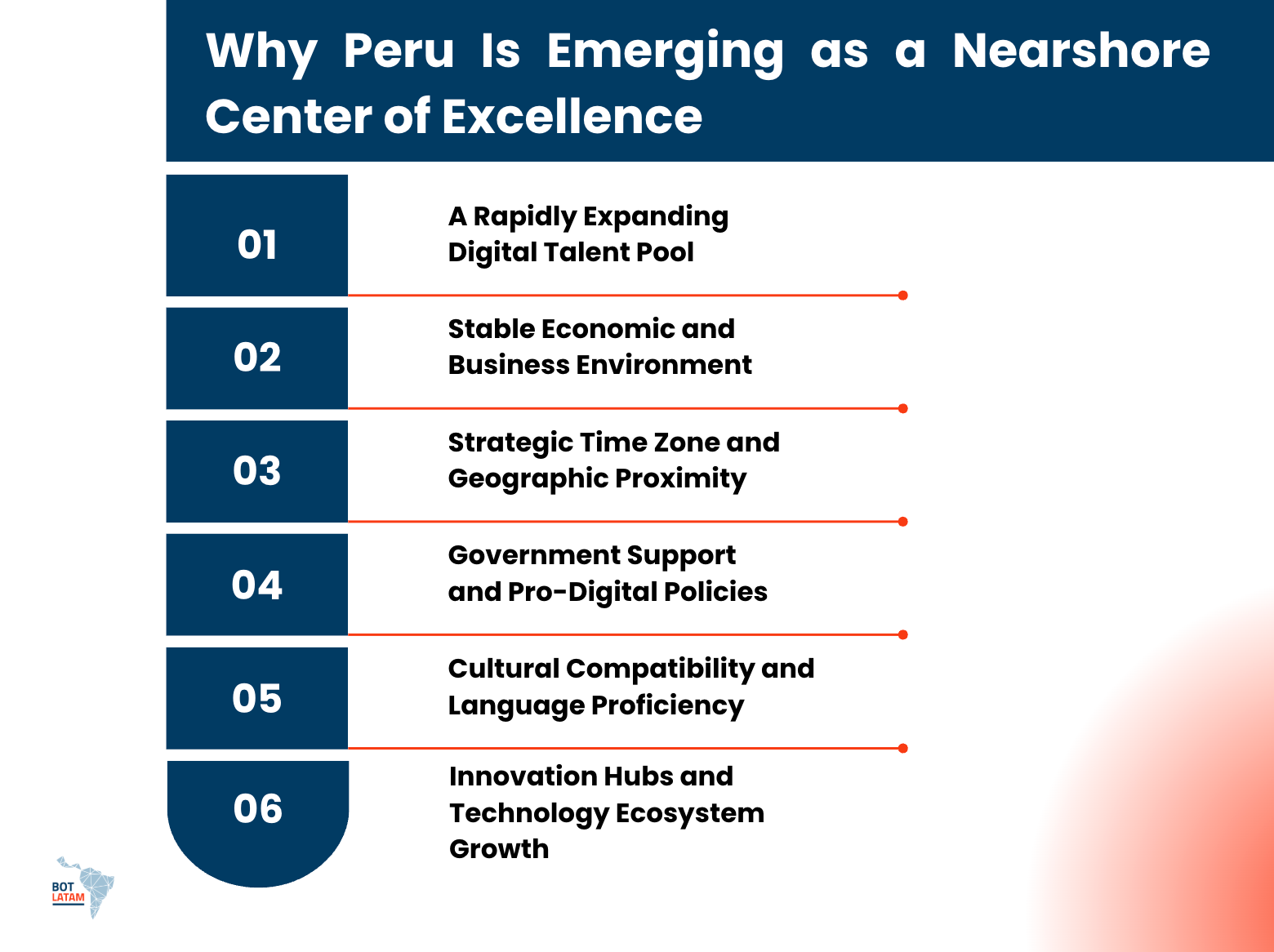Setting up a Nearshore Center of Excellence (CoE) in Peru is becoming one of the smartest ways for global companies to scale innovation and efficiency across LATAM. With its strong tech talent pool, growing digital infrastructure, and business-friendly environment, Peru is positioning itself as a serious contender for nearshore expansion.
You’ll learn how to establish a Nearshore CoE in Peru from the ground up, from understanding the model and evaluating locations to leveraging the Build-Operate-Transfer framework for sustainable growth. The article also explores Peru’s competitive advantages, its alignment with U.S. time zones, and why multinational firms are using it as a regional operations hub.
According to the Inter-American Development Bank, Latin America’s digital economy is projected to reach $500 billion by 2030, driven by nearshore technology partnerships and local innovation. For businesses aiming to gain efficiency without sacrificing control, a Peru CoE could be the next strategic move.
What Is a Nearshore Center of Excellence (CoE)?
A Nearshore Center of Excellence (CoE) is a specialized operational hub designed to centralize critical functions such as software development, IT operations, or business process management in a nearby country. Unlike traditional outsourcing setups, a Nearshore CoE combines proximity, control, and strategic alignment with your core business goals. It’s not just a cost-saving measure but a long-term capability-building strategy.
When you set up a Nearshore CoE, you’re essentially creating a dedicated center that mirrors your company’s culture, quality standards, and innovation practices. This structure allows you to tap into skilled regional talent while maintaining oversight of workflows, performance, and data security. The nearshore element ensures smoother collaboration thanks to overlapping time zones and cultural similarities. According to Deloitte’s 2024 Global Shared Services and Outsourcing Survey, over 60% of enterprises now prefer nearshore delivery models for improved agility and governance compared to offshore alternatives.
A strong CoE also drives knowledge retention and operational excellence. Teams aren’t just executing tasks, they’re building and refining best practices that can scale across your organization. By focusing on continuous improvement and innovation, a Nearshore CoE becomes a growth engine rather than a support function. In regions like Latin America, this model has gained traction as companies seek a balance between quality, speed, and cost-efficiency.
Why Peru Is Emerging as a Nearshore Center of Excellence

A Rapidly Expanding Digital Talent Pool.
Peru’s growing base of skilled professionals is one of its biggest assets for companies establishing a Nearshore Center of Excellence (CoE). The Inter-American Development Bank (IDB) reports that over 30,000 STEM graduates enter Peru’s workforce annually, with strong concentrations in software engineering, data science, and IT services. This influx of technical talent is being accelerated by both private and public investments in digital education programs. Initiatives like Beca 18 and partnerships with international tech academies have increased the availability of professionals ready to support enterprise-level CoE operations.
Peru’s younger workforce is also adapting quickly to global business demands. According to LinkedIn’s Emerging Jobs Report for LATAM, Peru ranks among the top five countries in Latin America for growth in cloud computing, cybersecurity, and AI-related roles, a clear indicator of its evolving nearshore capabilities.
Stable Economic and Business Environment.
Economic predictability is another key reason Peru is emerging as a preferred location for nearshore excellence. The World Bank notes that Peru has maintained one of the lowest inflation rates in Latin America over the past decade while achieving consistent GDP growth, driven by exports and digital services. This stability provides a dependable environment for long-term investments, reducing the operational risks typically associated with emerging markets.
Additionally, Peru’s favorable tax policies and open trade agreements, including membership in the Pacific Alliance, strengthen its position as a nearshore operations hub for North American companies. For CoE setups, this means smoother cross-border transactions and simplified compliance frameworks.
Strategic Time Zone and Geographic Proximity.
Peru’s time zone alignment with North America offers a distinct advantage for companies requiring seamless collaboration. Sharing Eastern Standard Time (EST) for much of the year allows real-time communication between Peruvian teams and U.S. headquarters. This eliminates delays in project management and decision-making, a frequent challenge in offshore models based in Asia or Eastern Europe.
Geographically, Peru’s well-developed infrastructure and direct flight connections to major U.S. cities like Miami, Houston, and Los Angeles make travel and oversight efficient. The result is a nearshore setup that functions as a true extension of your home operations rather than a distant outsourced site.
Government Support and Pro-Digital Policies.
Peru’s government has been actively promoting digital transformation as a national priority. The National Digital Policy of Peru outlines initiatives that strengthen connectivity, foster public-private collaboration, and expand technology access across the country. Through programs like StartUp Peru, the government is encouraging innovation and the creation of technology-driven companies, providing fertile ground for establishing Centers of Excellence.
This policy-driven approach is paying off. Peru ranked among the top 10 improvers in the World Bank’s Digital Readiness Index 2024, reflecting faster adoption of cloud technologies, e-governance systems, and cybersecurity standards, all essential components for supporting a high-performing CoE.
Cultural Compatibility and Language Proficiency.
Cultural alignment plays a major role in the success of any nearshore partnership, and Peru stands out for its adaptability and strong communication skills. English proficiency has been steadily improving, particularly among the urban professional class. The EF English Proficiency Index 2024 places Peru in the “moderate proficiency” tier, ahead of several regional peers, with Lima and Arequipa leading in bilingual talent availability.
This combination of language fluency and cultural understanding helps create smoother workflows and team integration with North American organizations, reducing the friction often seen in offshore collaborations.
Innovation Hubs and Technology Ecosystem Growth.
The rise of innovation hubs across Peru, especially in Lima, Arequipa, and Trujillo, is fueling a growing tech ecosystem ideal for building Centers of Excellence. Supported by incubators, universities, and foreign investment, these hubs are fostering collaboration between startups, academia, and enterprise partners.
Organizations like Peru Tech Hub and Wayra Perú have been instrumental in connecting local talent with global technology initiatives, making it easier to scale specialized teams within a CoE framework. This momentum positions Peru as not just a cost-efficient destination, but a center for continuous innovation and operational excellence in LATAM.
Steps to Set Up a Nearshore CoE in Peru
1. Conduct Market and Feasibility Research
Start by assessing whether Peru’s market conditions align with your operational goals. Analyze factors such as labor availability, salary ranges, and local competition. According to Glassdoor, mid-level software developers in Lima earn an average of $18,000–$25,000 annually, significantly lower than U.S. averages, while maintaining comparable skill levels.
Evaluate infrastructure quality, internet connectivity, and city-level digital readiness. Lima leads in connectivity and tech talent density, while Arequipa and Trujillo offer emerging regional opportunities. Reliable data from the World Economic Forum’s Network Readiness Index shows Peru’s consistent rise in ICT adoption, signaling an environment ready for scalable operations.
2. Select the Right Location for Your Peru CoE
Choosing the right city is critical to your CoE’s long-term success. Lima remains the preferred hub due to its advanced infrastructure, international connectivity, and concentration of bilingual professionals. Arequipa and Trujillo provide growing ecosystems with lower operational costs and less saturation.
Evaluate each region’s access to universities, talent pipelines, and technology clusters. The Peruvian Ministry of Labor highlights that over 60% of Peru’s IT graduates are concentrated in Lima and Arequipa, making these areas prime choices for scaling your teams efficiently.
3. Establish Legal and Regulatory Foundations
Before setting up operations, you’ll need to define your business structure and comply with Peruvian corporate and labor laws. Registering a legal entity can be done through SUNARP (Superintendencia Nacional de los Registros Públicos), typically taking between 15 to 25 business days.
Understand local taxation requirements, corporate tax rates stand at 29.5%, according to KPMG’s 2024 Peru Tax Guide. Also, consider double taxation agreements with countries such as the U.S., Canada, and Chile to streamline financial operations. Consulting with local legal advisors can help you ensure compliance with SUNAT (the national tax authority) and labor standards before scaling.
4. Build Infrastructure and Technology Capabilities
Your Nearshore CoE in Peru will require a secure and scalable IT infrastructure. Identify whether to lease office space, adopt hybrid work models, or build a fully remote setup. According to Colliers International Peru, office rental prices in Lima’s business districts average $15–$18 per square meter, offering flexibility for multi-team configurations.
Ensure compliance with international data privacy and cybersecurity frameworks, such as ISO 27001 and Peru’s Personal Data Protection Law (Law No. 29733). Establishing a robust cloud infrastructure early helps maintain operational continuity and supports future scalability.
5. Recruit and Develop Local Talent
Peru’s growing pool of engineers, developers, and business analysts provides a solid foundation for staffing your CoE. Collaborate with local universities such as Pontificia Universidad Católica del Perú (PUCP) to access top graduates.
To retain talent, emphasize professional development and international exposure. The OECD Skills Outlook 2024 highlights that continuous training programs can improve productivity by up to 15% in developing digital economies. Implement structured onboarding and cross-cultural training to align new hires with your company’s standards and methodologies.
6. Implement Governance and Performance Structures
Strong governance ensures that your CoE delivers measurable value. Define clear KPIs related to productivity, quality, and cost efficiency. Adopt frameworks like ITIL or COBIT for process management and performance tracking.
Establish leadership roles locally to oversee day-to-day operations, while maintaining integration with your global headquarters. Transparent communication and accountability frameworks help sustain alignment and operational discipline across teams.
7. Leverage the Build-Operate-Transfer (BOT) Model
If you’re new to nearshoring, the BOT model can reduce setup risk. In this model, a local partner builds and operates your CoE during the initial phase, later transferring full ownership to your organization once it’s stable and performing. The BOT structure is gaining traction across LATAM due to its balance of control and flexibility.
8. Scale and Optimize Operations Over Time
Once your Nearshore CoE in Peru is operational, continuous improvement becomes essential. Introduce automation, AI-driven analytics, and agile methodologies to enhance efficiency. Encourage knowledge sharing across teams to build internal expertise and innovation capacity.
Regularly review your CoE’s performance against strategic objectives. Adjust your structure, technology stack, or talent mix as business needs evolve. Over time, your Peru CoE can evolve from a delivery hub into a regional innovation center, one that drives measurable value for your global operations.
Leveraging the BOT Model for a Peruvian CoE
Understanding the Build-Operate-Transfer (BOT) Framework:
The Build-Operate-Transfer (BOT) model is a structured approach that allows companies to establish a Nearshore Center of Excellence (CoE) in Peru with reduced risk and faster deployment. Under this model, a local partner handles the initial setup, including recruitment, infrastructure, and operations, before transferring full ownership once the center is stable and fully operational.
This model has gained traction across Latin America due to its scalability and flexibility. For companies new to Peru’s regulatory or labor environment, BOT offers a clear pathway to establishing operations without the complexities of immediate incorporation.
How BOT Accelerates CoE Setup in Peru:
Implementing a BOT structure in Peru helps accelerate the process of launching a fully functional CoE. The Build phase involves creating the operational foundation, from hiring local staff and setting up IT systems to ensuring compliance with Peruvian tax and labor laws. During the Operate phase, the local partner manages daily operations, optimizing workflows, training teams, and achieving performance benchmarks. Finally, in the Transfer phase, full ownership transitions to your organization, typically after 18–36 months.
This staged approach enables a smooth handover with minimal disruption. It also provides time to understand local market nuances, adapt governance models, and integrate corporate culture before taking direct control. KPMG notes that BOT setups often achieve operational readiness 25–30% faster than traditional in-house builds.
Key Benefits of Leveraging BOT for a Peruvian CoE:
The BOT model offers several strategic advantages when establishing a CoE in Peru. It reduces upfront investment risk, as the local partner assumes much of the initial cost and compliance burden. It also provides access to pre-vetted local talent, often through established recruitment networks, which shortens hiring cycles and improves retention during the transition phase.
Additionally, Peru’s strong digital infrastructure and skilled workforce make the BOT model particularly effective. The gradual transfer of operations ensures process maturity before full ownership, minimizing productivity drops.
Governance and Knowledge Transfer in the BOT Transition:
One of the most important aspects of a BOT arrangement is the knowledge transfer process. Clear documentation, performance metrics, and leadership overlap between the operating partner and your management team ensure continuity once the CoE transitions to full ownership.
To strengthen governance, establish dual leadership during the final months of the Operate phase. This allows your internal team to shadow local managers, understand compliance frameworks, and gain full operational visibility. Regular audits and milestone-based reviews ensure the CoE’s processes align with corporate standards before the official transfer.
Well-executed knowledge transfer not only preserves operational integrity but also enhances long-term scalability. By the time the transfer is complete, your Peruvian CoE operates with the same efficiency, governance, and cultural integration as your global headquarters, without the growing pains of a traditional market entry.
Ready to Set Up a Nearshore CoE in Peru?
Building a Nearshore Center of Excellence (CoE) in Peru isn’t just a cost-efficient strategy; it’s a way to future-proof operations through local expertise, regional scalability, and long-term innovation. With Peru’s maturing digital economy and strong government support for technology development, companies that act early can establish a significant advantage in LATAM’s fast-evolving nearshore landscape.
At BOT LATAM, we help global organizations design, launch, and scale Nearshore CoEs across Latin America using proven Build-Operate-Transfer frameworks. Our team has guided multiple enterprises through setup, governance, and operational transfer, ensuring compliance, efficiency, and measurable ROI from day one. As LATAM’s digital economy is projected to keep growing, having a trusted local partner can make the difference between a successful expansion and a costly experiment.
Through transparent operations, local expertise, and end-to-end support, at BOT LATAM, we enable companies to build Centers of Excellence in Latin America that deliver real performance, innovation, and long-term value, not just a nearshore presence. Contact us to learn how we can help you set up your own CoE!

Revolutionize Your Workflow with Our Innovative BOT Strategy!
Enhance your operations seamlessly and adapt to market demands
Contact Us

.jpg)


%2017.26.38.png)